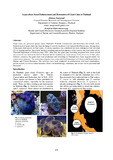Aquaculture-based Enhancement and Restoration of Giant Clam in Thailand
นามธรรม
Giant clams are protected species under Thailand's Wildlife Conservation and Protection Act of B.E. 2535. Natural stock of giant clams has been declining to scarcity in almost every natural distribution area. Among three living giant clam species in Thai waters, Tridacna squamosa was considered the most endangered with less than 1% in existing number. Successful hatchery breeding and seed production of this species has been achieved by Thailand Department of Fisheries since 1993. After that, the giant clam restocking programs have been carried out at several sites both in the Gulf of Thailand and the Andaman Sea with various levels of success. Unlike other fisheries resources, the giant clam seed production and restocking in Thailand have been targeted mainly for conservation purposes. The restocking programs were cooperated by Department of Fisheries and Department of Marine and Coastal Resources. The activities have been conducted in collaboration with local communities, private sectors, as well as conservationists. Details on methodology, constraints, and results will be presented and discussed.
การอ้างอิง
Nugranad, J., & Kittiwattanawong, K. (2016). Aquaculture-based enhancement and restoration of giant clam in Thailand. In H. Kawamura, T. Iwata, Y. Theparoonrat, N. Manajit, & V. T. Sulit (Eds.), Consolidating the Strategies for Fishery Resources Enhancement in Southeast Asia. Proceedings of the Symposium on Strategy for Fisheries Resources Enhancement in the Southeast Asian Region, Pattaya, Thailand, 27-30 July 2015 (pp. 171-173). Samutprakan, Thailand: Training Department, Southeast Asian Fisheries Development Center.
เรื่อง
resource management; stocking (organisms); Refuges; resource conservation; fishermen; food security; habitat loss; fishery resources; artificial reefs; Habitat improvement (biological); fish kill; socioeconomic aspects; depleted stocks; environmental effects; stocks; reproduction; Brood stocks; Cambodia

